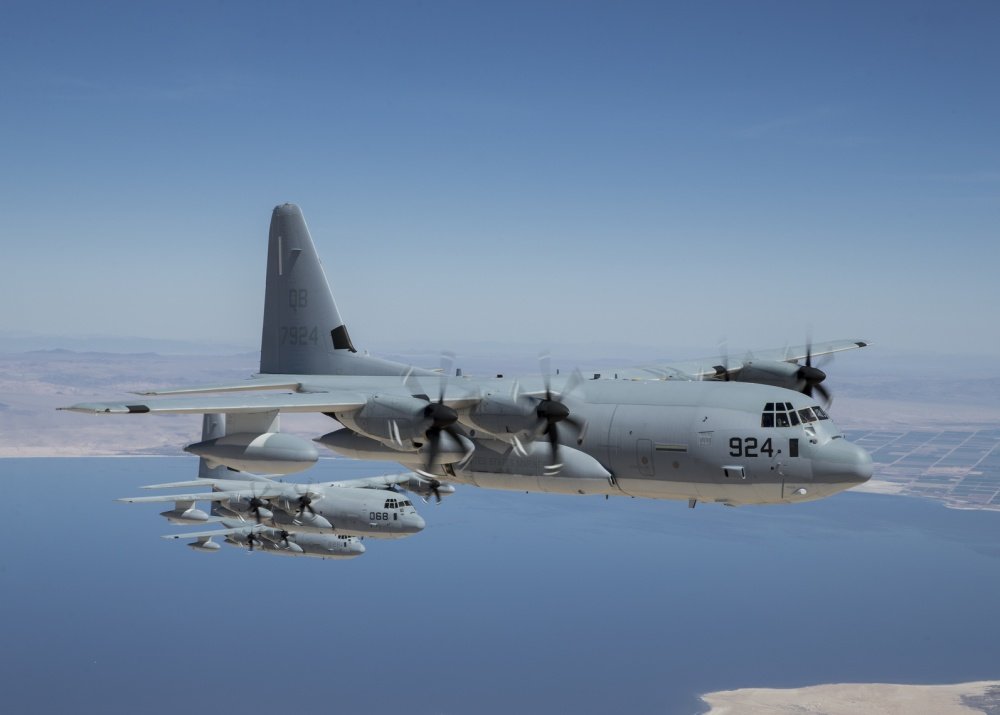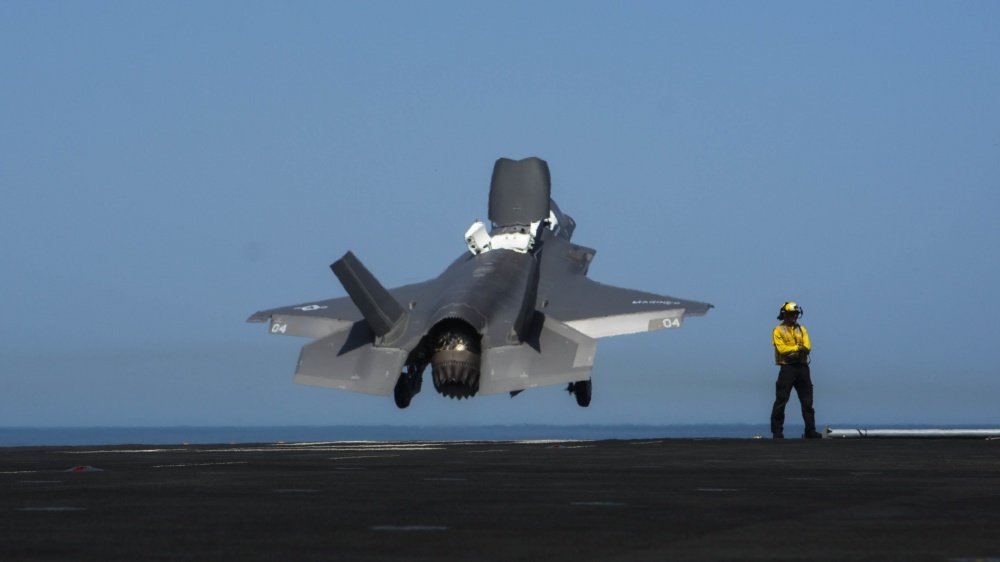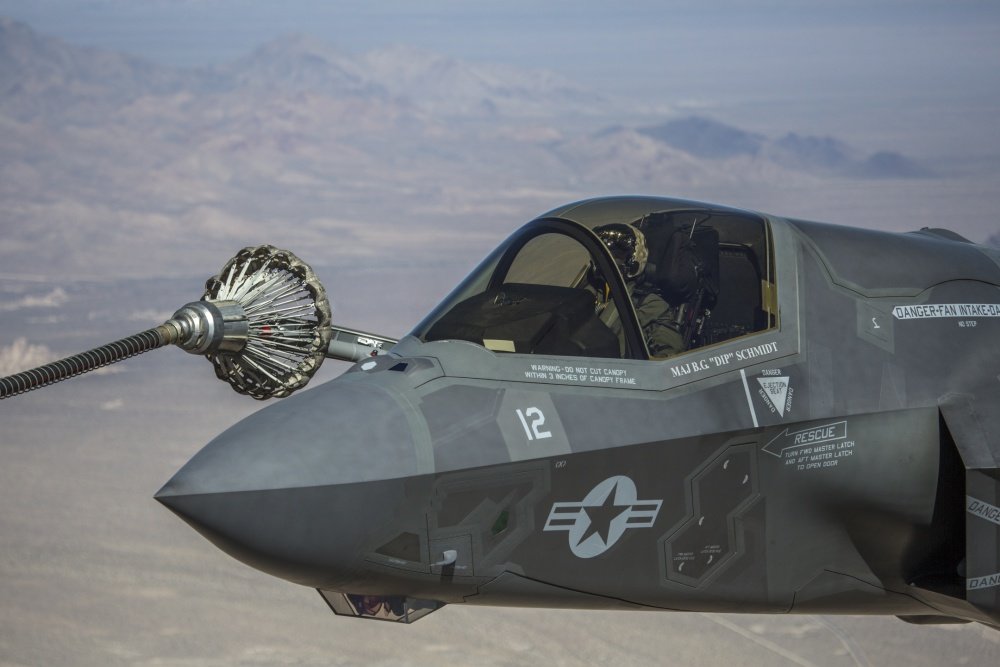Marine Corps F-35B Crashes After Colliding with Tanker Over Southern California, All Aircrew Survive

The F-35B made its first transatlantic flight June 29, 2016. Three F-35’s flew from MCAS Beaufort in South Carolina and landed at RAF Fairford in Gloucestershire, England. U.S. Marine Corps photo by Cpl. Brian Burdett/Released via DVIDS.
A Marine Corps F-35B Lightning II warplane crashed after colliding with a KC-130J aerial tanker during an air-to-air refueling operation near the Salton Sea in Southern California on Tuesday afternoon, the Marine Corps reported.
The F-35 pilot ejected and survived, according to military officials. The eight crew members of the KC-130J tanker all survived after a harrowing forced landing in a farm field near Jacqueline Cochran Regional Airport in Thermal, California, local media agencies reported. Photos posted to social media show the KC-130J missing several propeller blades, implying the pilots likely lost power from at least one engine and had multiple other onboard emergencies to deal with.
The survival of all crew members is being hailed by many aviation experts as a testament to the professionalism and skills of the KC-130J’s crew.
#BREAKING A plane made an emergency landing in a farm field in Thermal just East if the airport. Early reports of 8 on board. It reportedly clipped another plane mid-air. We are live in scene wirh the early details. @KESQ pic.twitter.com/b4rDWJgoat
— Jake Ingrassia (@JakeKESQ) September 30, 2020
Marine Aviation’s stalwart air refueling platform, the KC-130J Super Hercules tanker is a modified version of the venerable C-130 cargo plane — a design that dates back to the 1950s. The KC-130J involved in Tuesday’s incident belongs to Marine Aerial Refueler Transport Squadron 352, the “Raiders,” which is part of the 3rd Marine Airlift Wing based at Marine Corps Air Station Miramar in California.
The stricken F-35B crashed near Naval Air Facility El Centro in California; there are currently no reports of casualties on the ground. Local news reports showed a plume of smoke from the presumed F-35 crash site, which appeared to be in an empty field with no structures located nearby.

The Lockheed Martin F-35 Lightning II is a fifth-generation, multirole, stealth fighter-bomber operated by the Air Force, Navy, and Marine Corps — as well as a number of US allies. According to Lockheed Martin, nine countries currently operate F-35s on their territories.
The Air Force flies the F-35A, and the Navy operates the F-35C. All F-35 variants have a single engine and are flown by one pilot. Of the three variants, the Marine Corps’ F-35B is the most expensive, with a per-unit price tag of about $108 million compared with $80 million for the Air Force’s F-35A, according to data posted on Lockheed Martin’s website.

That extra expense is due to the F-35B’s short takeoff and vertical landing, or STVOL, capability. To achieve this, the F-35B features a swiveling lift fan in its fuselage, along with a thrust-vectoring nozzle out the engine, providing some 40,000 pounds of total vertical thrust. Those features allow the F-35B to take off and land practically anywhere — but they also cut down on the warplane’s internal weapons payload and fuel storage capacity compared with other variants.
According to Lockheed Martin, the F-35B and C both use the “probe-and-drogue” method of aerial refueling, involving a loose hose trailed behind a tanker that is stabilized in flight by a drogue. The Air Force’s F-35A variant is designed to refuel by connecting with a solid boom. Unlike the probe-and-drogue system, the Air Force’s aerial refueling boom must be guided by a human controller aboard the tanker aircraft.

The Marine Corps introduced the F-35B in 2015, and the Marine variant flew its first combat sortie in Afghanistan in September 2018.
“The F-35’s mission is to attack and destroy surface targets, intercept and destroy enemy aircraft, provide electronic warfare support, and network enabled reconnaissance support across the full spectrum of combat operations,” according to a readout on the US Marine Corps website.
As of January 2017, a squadron of F-35Bs is permanently based at Marine Corps Air Station Iwakuni, in Japan. The F-35B aircraft involved in Tuesday’s incident was reportedly assigned to MCAS Iwakuni, ABC News reported.
Tuesday’s aerial refueling incident marks the fourth crash of the F-35. The Marine Corps said it is investigating the incident.

BRCC and Bad Moon Print Press team up for an exclusive, limited-edition T-shirt design!
BRCC partners with Team Room Design for an exclusive T-shirt release!
Thirty Seconds Out has partnered with BRCC for an exclusive shirt design invoking the God of Winter.
Lucas O'Hara of Grizzly Forge has teamed up with BRCC for a badass, exclusive Shirt Club T-shirt design featuring his most popular knife and tiomahawk.
Coffee or Die sits down with one of the graphic designers behind Black Rifle Coffee's signature look and vibe.
Biden will award the Medal of Honor to a Vietnam War Army helicopter pilot who risked his life to save a reconnaissance team from almost certain death.
Ever wonder how much Jack Mandaville would f*ck sh*t up if he went back in time? The American Revolution didn't even see him coming.
A nearly 200-year-old West Point time capsule that at first appeared to yield little more than dust contains hidden treasure, the US Military Academy said.












